

Gulshan-i Raz. Abu al-Qasim al-Zahrawi. Abu al-Qasim Khalaf ibn al-Abbas Al-Zahrawi (936–1013), (Arabic: أبو القاسم خلف بن العباس الزهراوي) also known in the West as Albucasis, was an Arab Muslim physician who lived in Al-Andalus.

He is considered the greatest medieval surgeon to have appeared from the Islamic World, and has been described by many as the father of modern surgery.[1] His greatest contribution to medicine is the Kitab al-Tasrif, a thirty-volume encyclopedia of medical practices.[2] His pioneering contributions to the field of surgical procedures and instruments had an enormous impact in the East and West well into the modern period, where some of his discoveries are still applied in medicine to this day.[3] He was the first physician to describe an ectopic pregnancy, and the first physician to identify the hereditary nature of haemophilia.[3] Biography[edit] He lived most of his life in Córdoba.
Works[edit] Hunayn ibn Ishaq. Hunayn ibn Ishaq (also Hunain or Hunein) (Syriac: ܚܢܝܢ ܒܪ ܐܝܣܚܩ, Arabic: أبو زيد حنين بن إسحاق العبادي; ’Abū Zayd Ḥunayn ibn ’Isḥāq al-‘Ibādī, known in Latin as Johannitius) (809–873) was a famous and influential Assyrian[1] Nestorian Christian scholar, physician, and scientist, known for his work in translating Greek scientific and medical works into Arabic and Syriac during the heyday of the Islamic Abbasid Caliphate.

Ḥunayn ibn Isḥaq was the most productive translator of Greek medical and scientific treatises in his day. He studied Greek and became known among the Arabs as the "Sheikh of the translators. " He mastered four languages: Arabic, Syriac, Greek and Persian. His translations did not require corrections.
Hunayn’s method was widely followed by later translators. Mu'allaqat. Mu'allaqat (en árabe معلقات) es el título de un grupo de siete largos poemas árabes o qasida compuestos en la época preislámica.

Están considerados como el mejor trabajo poético de su época. Teopompo. Teopompo (Quíos, 380 a.
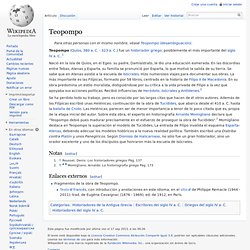
C. - 323 a. C.) fue un historiador griego, posiblemente el más importante del siglo IV a. C..[1] Lucullus. Palmyra. Palmyra /ˌpælˈmaɪərə/, (Aramaic: ܬܕܡܘܪܬܐ; Arabic: تدمر; Hebrew: תַּדְמוֹר; Ancient Greek: Παλμύρα), was an ancient Semitic city, located in Homs Governorate, Syria.
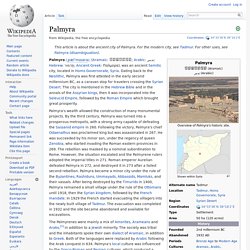
Herculaneum. Located in the shadow of Mount Vesuvius, Herculaneum (Italian: Ercolano) was an ancient Roman town destroyed by volcanic pyroclastic flows in 79 AD.
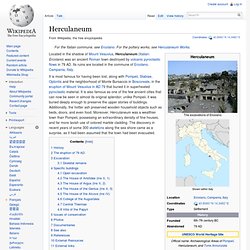
Its ruins are located in the commune of Ercolano, Campania, Italy. It is most famous for having been lost, along with Pompeii, Stabiae, Oplontis and the neighborhood of Monte Bursaccio in Boscoreale, in the eruption of Mount Vesuvius in AD 79 that buried it in superheated pyroclastic material. It is also famous as one of the few ancient cities that can now be seen in almost its original splendor; unlike Pompeii, it was buried deeply enough to preserve the upper stories of buildings.
Additionally, the hotter ash preserved wooden household objects such as beds, doors, and even food. Moreover, Herculaneum was a wealthier town than Pompeii, possessing an extraordinary density of fine houses, and far more lavish use of colored marble cladding. History[edit] Defrutum. Defrutum (denominado también caroenum) es un tipo de vino reducido a mitad de su volumen, era muy empleado en la época del Imperio romano.
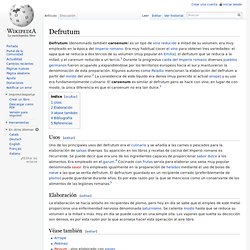
Era muy habitual cocer el vino para obtener tres variedades: el sapa que se reducía a dos tercios de su volumen (muy popular en Emilia), el defrutum que se reducía a la mitad, y el carenum reducido a un tercio.[1] Durante la progresiva caída del Imperio romano diversos pueblos germanos fueron ocupando y expandiéndose por los territorios europeos hacia el sur y mantuvieron la denominación de esta preparación. Algunos autores como Paladio mencionan la elaboración del defrutum a partir del mosto del vino.[2] La consistencia de este líquido era densa (muy parecido al actual sirope) y su uso era fundamentalmente culinario.
Silfio. Moneda de plata de Cirene mostrando una gavilla de laserpicio.
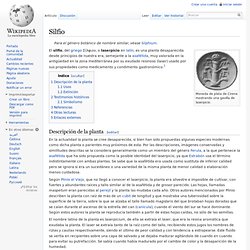
El silfio, del griego Σίλφιον, o laserpicio en latín, es una planta desaparecida desde principios de nuestra era, semejante a la asafétida, muy valorada en la antigüedad en la zona mediterránea por su exudado resinoso (laser) usado por sus propiedades como medicamento y condimento gastronómico.[1] Boticario. Botica medieval.

Un boticario (también llamado apothicario o apothecario) es aquella persona que está en una oficina de farmacia o botica (que proviene de la voz griega apotheka, almacén o tienda de víveres). Hasta el final del siglo XVII es el nombre que recibe el maestro que está en la botica, que es un establecimiento donde se realizaban los remedios que prescribían los médicos. Desde el siglo XV, había que obtener el título de maestro boticario mediante un examen para poder ejercer la profesión. Aulus Gellius. Aulus Gellius (c. 125 – after 180 AD) was a Latin author and grammarian, who was probably born and certainly brought up in Rome.
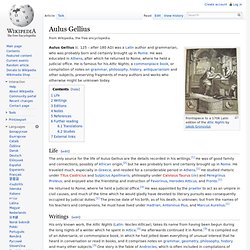
He was educated in Athens, after which he returned to Rome, where he held a judicial office. He is famous for his Attic Nights, a commonplace book, or compilation of notes on grammar, philosophy, history, antiquarianism and other subjects, preserving fragments of many authors and works who otherwise might be unknown today. De re coquinaria. Página del título de una edición holandesa del siglo XVIII de Apicio, incluyendo también el título alternativo Arte Coquinaria.
De re coquinaria (Sobre materia de cocina) es un recetario en latín. Esta obra se atribuye a un autor romano llamado Marco Gavio Apicio, que vivió en el siglo I, durante el reinado de Tiberio, pero en realidad se trata de una obra del siglo IV o V. El libro ofrece no sólo un conjunto de recetas sino que enseña diversos trucos culinarios para reutilizar, por ejemplo, las sobras de los alimentos cocinados o para preparar platos similares, pero con complejidad y costes diferentes. Procopius. Procopius of Caesarea (Latin: Procopius Caesarensis, Greek: Προκόπιος ὁ Καισαρεύς; c. AD 500 – c. AD 565) was a prominent late antique scholar from Palaestina Prima.[1] Accompanying the Roman general Belisarius in the wars of the Emperor Justinian, he became the principal historian of the 6th century, writing the Wars of Justinian, the Buildings of Justinian and the celebrated Secret History. He is commonly held to be the last major historian of the ancient world. Life[edit] Apart from his own writings, the main source for Procopius' life is an entry in the Suda,[2] a 10th-century Byzantine encyclopedia that tells nothing about his early life.
It is not known when Procopius himself died, and many historians (James Howard-Johnson, Averil Cameron, Geoffrey Greatrex) date his death to 554, but in 562 there was an urban prefect of Constantinople who happened to be called Procopius. Greek Anthology. The van Bosch and van Lennep version of The Greek Anthology (in five vols., begun by Bosch in 1795, finished and published by Lennep in 1822). Photographed at The British Museum, London. Contains the metrical Latin version of Grotius's Planuedean version of the Anthology. Heavily illustrated. Lituus. Augur portando un lituus. Un lituus o lituo es una palabra etrusca en su origen, que podría traducirse como torcido, curvo y, pasó a la Antigua Roma para designar un bastón ritual augural.
Lernaean Hydra. The Second Labour of Heracles[edit] Eurystheus sent Heracles to slay the Hydra, which Hera had raised just to slay Heracles. Historia Plantarum. Historia Plantarum is Latin and literally means History of Plants, although better translations would be "on plants" or "treatise on plants". There has been more than one book by this title. Vicus Tuscus. Map of central Rome during the Roman Empire showing Vicus Tuscus at the center Vicus Tuscus ("Etruscan Street" or "Tuscan Street") was an ancient street in the city of Rome, running southwest out of the Forum Romanum between the Basilica Iulia and the Temple of Castor and Pollux towards the Forum Boarium and Circus Maximus via the west side of the Palatine Hill and Velabrum.[1]
Cneo Calpurnio Pisón (cónsul 7 a. C.) Cneo Calpurnio Pisón (padre, para diferenciarlo de su hijo con el mismo nombre), fue un político del Imperio romano nacido en 44 a. Ephesus. List of ancient tribes in Illyria. This is a list of ancient tribes in the ancient territory of Illyria (Ancient Greek: Ἰλλυρία). Antarah ibn Shaddad. 'Antarah Ibn Shaddād al-'Absī عنترة بن شداد العبسي was a pre-Islamic Arab hero and poet (525-608) famous for both his poetry and his adventurous life.
What many consider his best or chief poem is contained in the Mu'allaqat. The account of his life forms the basis of a long and extravagant romance. Biography[edit] Antarah and Abla depicted on a 19th-century Egyptian tattooing pattern. A recent photo of, what is said to be, the famous Rock where Antarah used to meet Abla. Antara Ibn Shaddad عنترة إبن شداد (commonly known as Antar) was a pre-Islamic poet born in Najd (Northern Saudi Arabia today).
Dioscórides. Pedanio (o Pedacio) Dioscórides Anazarbeo (Anazarbus, Cilicia, en Asia Menor, c. 40 - c. 90) fue un médico, farmacólogo y botánico de la antigua Grecia, cuya obra De Materia Medica alcanzó una amplia difusión y se convirtió en el principal manual de farmacopea durante toda la Edad Media y el Renacimiento. Escuela de Traductores de Toledo. El nombre de Escuela de traductores de Toledo designa en la historiografía, desde el siglo XIII, a los distintos procesos de traducción e interpretación de textos clásicos greco-latinos alejandrinos, que habían sido vertidos del árabe o del hebreo a la lengua latina sirviéndose del romance castellano o español como lengua intermedia, o directamente a las emergentes «lenguas vulgares», principalmente al castellano. La conquista en 1085 de Toledo y la tolerancia que los reyes castellanos cristianos dictaron para con musulmanes y judíos facilitaron este comercio cultural que permitió el renacimiento filosófico, teológico y científico primero de España y luego de todo el occidente cristiano.
Hoy, la prestigiosa y antigua Escuela de Traductores de Toledo es uno de los institutos culturales e investigadores de la Universidad de Castilla-La Mancha y tiene su sede en el antiguo Palacio del Rey Don Pedro en la toledana Plaza de Santa Isabel. Adab (comportamiento) La adab, en árabe أدب, plural ildáb se ha definido como el conjunto de «ciencias propedéuticas entre los árabes». El término adab es, en un principio, sinónimo de sunna en el sentido de «uso, costumbre, norma de conducta correcta y recomendada, transmitida por los antepasados».
Calila y Dimna. Hitopadesha. Panchatantra. Dama de Elche. Eleusinian Mysteries. Agoge. Geronte. Constitución de los atenienses. Justiniano I. Concilios de Braga. Isagoge. Πολίτης. Bárbaro. Alanos. Homo homini lupus.